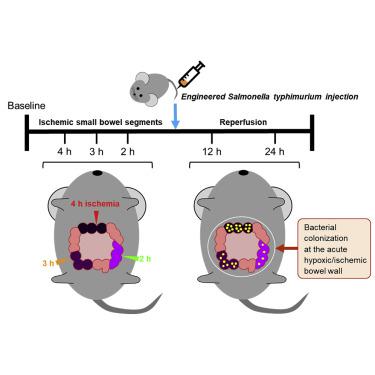Molecular Therapy - Methods & Clinical Development ( IF 4.6 ) Pub Date : 2020-06-25 , DOI: 10.1016/j.omtm.2020.06.021 Chung-Man Moon 1, 2 , Jin Hai Zheng 3, 4 , Jung-Joon Min 5 , Yong Yeon Jeong 6 , Suk-Hee Heo 6 , Sang-Soo Shin 7

|
This study aimed at investigating the feasibility of bioluminescence imaging (BLI) with engineered Salmonella typhimurium (ΔppGpp S. typhimurium) for visualizing acute hypoxic/ischemic bowels. At the start of 12- or 24-h reperfusion, ΔppGpp S. typhimurium was injected into the lateral tail veins of rats in which three segments of the small intestine were respectively subjected to 2, 3, and 4 h of ischemia. BLI and magnetic resonance imaging were performed at each reperfusion time point. Bioluminescence was exclusively detected in the hypoxic/ischemic segment of the intestine, showing the ability of ΔppGpp S. typhimurium to specifically target and proliferate in a hypoxic/ischemic area. Serial monitoring of these rat models revealed a progressive increase in bacterial bioluminescence in the ischemic intestines in conjunction with viable bacterial counts. The viable bacterial counts were positively correlated with lactate dehydrogenase levels after 24 h of reperfusion following 3 or 4 h of ischemia as well as interleukin-6 levels after 24 h of reperfusion following 4 h of ischemia. Our findings demonstrated that BLI was able to detect the acute hypoxic/ischemic bowel via monitoring of the distribution, internalization, and activity of administered ΔppGpp S. typhimurium. These findings may be useful for the early diagnosis of ischemic bowel disease.
中文翻译:

鼠伤寒沙门氏菌靶向急性缺氧/缺血性小肠的体内生物发光成像。
这项研究旨在研究工程化鼠伤寒沙门氏菌(ΔppGpp鼠伤寒沙门氏菌)用于可视化急性缺氧/缺血性肠的生物发光成像(BLI)的可行性。在12或24小时的再灌注开始时,将ΔppGpp鼠伤寒沙门氏菌注射到大鼠的侧尾静脉中,其中小肠的三个部分分别经历了2、3和4小时的局部缺血。在每个再灌注时间点进行BLI和磁共振成像。仅在肠的缺氧/缺血区检测到生物发光,显示出ΔppGpp鼠伤寒沙门氏菌的能力专门针对缺氧/缺血区域并在其中扩散。对这些大鼠模型的系列监测显示,与可行的细菌计数相结合,缺血性肠道细菌的生物发光逐渐增加。存活的细菌计数与缺血3或4小时再灌注24小时后的乳酸脱氢酶水平以及缺血4小时再灌注24小时后的白细胞介素6水平正相关。我们的研究结果表明,BLI能够通过监测所施用的ΔppGpp鼠伤寒沙门氏菌的分布,内在化和活性来检测急性低氧/缺血性肠。这些发现可能对缺血性肠病的早期诊断有用。











































 京公网安备 11010802027423号
京公网安备 11010802027423号